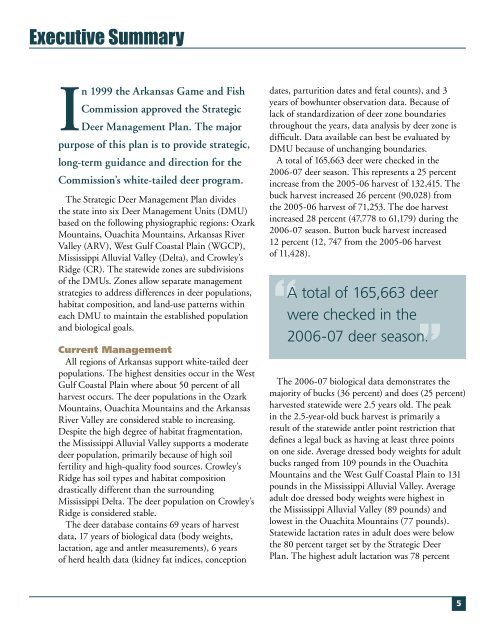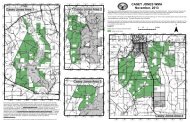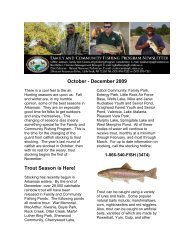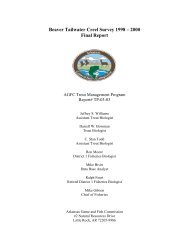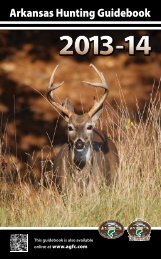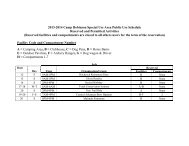2006-07 deer Report - Arkansas Game and Fish Commission
2006-07 deer Report - Arkansas Game and Fish Commission
2006-07 deer Report - Arkansas Game and Fish Commission
- No tags were found...
You also want an ePaper? Increase the reach of your titles
YUMPU automatically turns print PDFs into web optimized ePapers that Google loves.
Executive SummaryIn 1999 the <strong>Arkansas</strong> <strong>Game</strong> <strong>and</strong> <strong>Fish</strong><strong>Commission</strong> approved the StrategicDeer Management Plan. The majorpurpose of this plan is to provide strategic,long-term guidance <strong>and</strong> direction for the<strong>Commission</strong>’s white-tailed <strong>deer</strong> program.The Strategic Deer Management Plan dividesthe state into six Deer Management Units (DMU)based on the following physiographic regions: OzarkMountains, Ouachita Mountains, <strong>Arkansas</strong> RiverValley (ARV), West Gulf Coastal Plain (WGCP),Mississippi Alluvial Valley (Delta), <strong>and</strong> Crowley’sRidge (CR). The statewide zones are subdivisionsof the DMUs. Zones allow separate managementstrategies to address differences in <strong>deer</strong> populations,habitat composition, <strong>and</strong> l<strong>and</strong>-use patterns withineach DMU to maintain the established population<strong>and</strong> biological goals.Current ManagementAll regions of <strong>Arkansas</strong> support white-tailed <strong>deer</strong>populations. The highest densities occur in the WestGulf Coastal Plain where about 50 percent of allharvest occurs. The <strong>deer</strong> populations in the OzarkMountains, Ouachita Mountains <strong>and</strong> the <strong>Arkansas</strong>River Valley are considered stable to increasing.Despite the high degree of habitat fragmentation,the Mississippi Alluvial Valley supports a moderate<strong>deer</strong> population, primarily because of high soilfertility <strong>and</strong> high-quality food sources. Crowley’sRidge has soil types <strong>and</strong> habitat compositiondrastically different than the surroundingMississippi Delta. The <strong>deer</strong> population on Crowley’sRidge is considered stable.The <strong>deer</strong> database contains 69 years of harvestdata, 17 years of biological data (body weights,lactation, age <strong>and</strong> antler measurements), 6 yearsof herd health data (kidney fat indices, conceptiondates, parturition dates <strong>and</strong> fetal counts), <strong>and</strong> 3years of bowhunter observation data. Because oflack of st<strong>and</strong>ardization of <strong>deer</strong> zone boundariesthroughout the years, data analysis by <strong>deer</strong> zone isdifficult. Data available can best be evaluated byDMU because of unchanging boundaries.A total of 165,663 <strong>deer</strong> were checked in the<strong>2006</strong>-<strong>07</strong> <strong>deer</strong> season. This represents a 25 percentincrease from the 2005-06 harvest of 132,415. Thebuck harvest increased 26 percent (90,028) fromthe 2005-06 harvest of 71,253. The doe harvestincreased 28 percent (47,778 to 61,179) during the<strong>2006</strong>-<strong>07</strong> season. Button buck harvest increased12 percent (12, 747 from the 2005-06 harvestof 11,428).“A total of 165,663 <strong>deer</strong>were checked in the<strong>2006</strong>-<strong>07</strong> <strong>deer</strong> season.”The <strong>2006</strong>-<strong>07</strong> biological data demonstrates themajority of bucks (36 percent) <strong>and</strong> does (25 percent)harvested statewide were 2.5 years old. The peakin the 2.5-year-old buck harvest is primarily aresult of the statewide antler point restriction thatdefines a legal buck as having at least three pointson one side. Average dressed body weights for adultbucks ranged from 109 pounds in the OuachitaMountains <strong>and</strong> the West Gulf Coastal Plain to 131pounds in the Mississippi Alluvial Valley. Averageadult doe dressed body weights were highest inthe Mississippi Alluvial Valley (89 pounds) <strong>and</strong>lowest in the Ouachita Mountains (77 pounds).Statewide lactation rates in adult does were belowthe 80 percent target set by the Strategic DeerPlan. The highest adult lactation was 78 percent5


